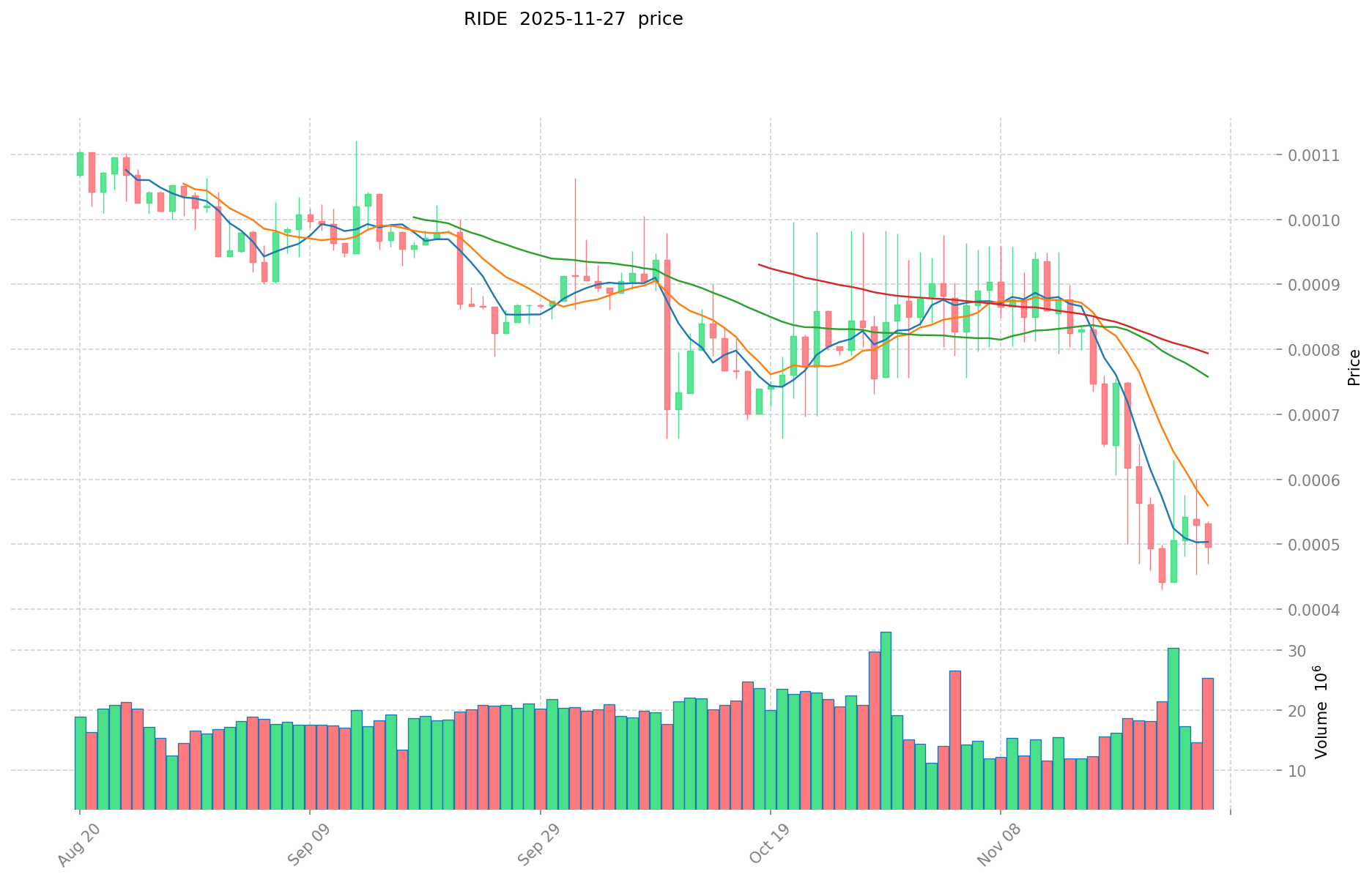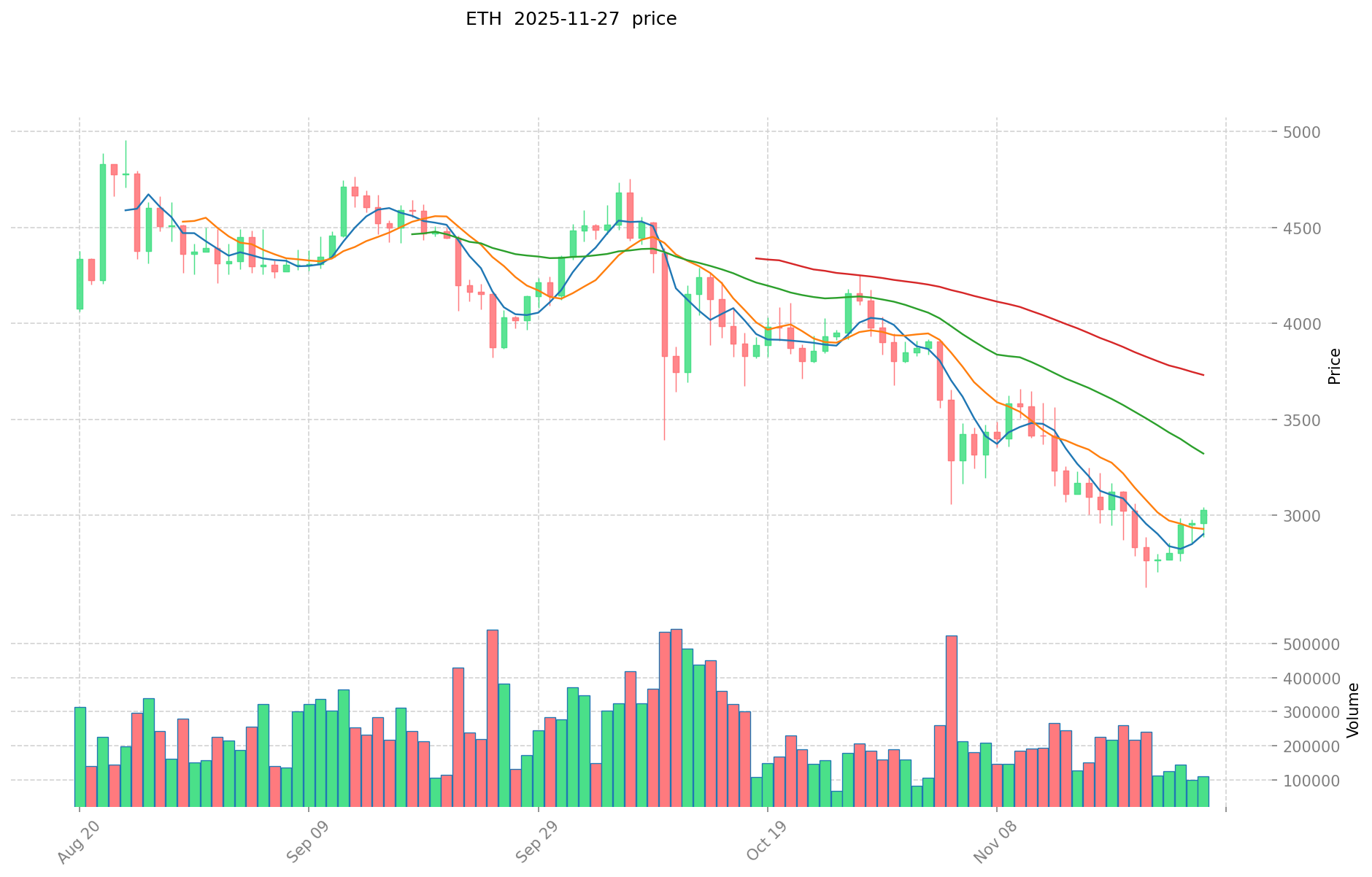RIDE vs ETH: A Comparative Analysis of Blockchain Platforms for Decentralized Applications
Introduction: Investment Comparison between RIDE and ETH
In the cryptocurrency market, the comparison between RIDE vs ETH has always been a topic that investors can't ignore. The two not only show significant differences in market cap ranking, application scenarios, and price performance, but also represent different cryptocurrency asset positioning.
RIDE (RIDE): Since its launch, it has gained market recognition for its positioning in the NFT-driven content ecosystem.
Ethereum (ETH): Since 2015, it has been hailed as the foundation for decentralized applications and smart contracts, and is one of the cryptocurrencies with the highest global trading volume and market capitalization.
This article will comprehensively analyze the investment value comparison between RIDE vs ETH, focusing on historical price trends, supply mechanisms, institutional adoption, technological ecosystems, and future predictions, and attempt to answer the question that investors care about most:
"Which is the better buy right now?"
I. Price History Comparison and Current Market Status
RIDE (Coin A) and ETH (Coin B) Historical Price Trends
- 2021: RIDE reached its all-time high of $2.5 on December 24, 2021, likely due to its initial launch and market enthusiasm.
- 2025: ETH achieved its all-time high of $4,946.05 on August 25, 2025, possibly influenced by broader crypto market trends or Ethereum network upgrades.
- Comparative analysis: In the recent market cycle, RIDE has fallen from its all-time high of $2.5 to a current price of $0.0004866, representing a significant decline. ETH, while also experiencing volatility, has shown more resilience, currently trading at $3,037.06, which is about 38.6% below its all-time high.
Current Market Situation (2025-11-27)
- RIDE current price: $0.0004866
- ETH current price: $3,037.06
- 24-hour trading volume: RIDE $12,269.71 vs ETH $354,248,276.60
- Market Sentiment Index (Fear & Greed Index): 22 (Extreme Fear)
Click to view real-time prices:
- View RIDE current price Market Price
- View ETH current price Market Price


II. Core Factors Affecting RIDE vs ETH Investment Value
Supply Mechanism Comparison (Tokenomics)
- RIDE: Fixed supply of 1 billion tokens with a strict release schedule; 60% allocated to the community through staking, games, and airdrops
- ETH: Deflationary model since EIP-1559 implementation; transaction fees are partially burned, reducing overall supply over time
- 📌 Historical pattern: Fixed supply tokens like RIDE tend to create scarcity value, while ETH's burn mechanism has proven effective in creating upward price pressure during high network usage periods.
Institutional Adoption and Market Applications
- Institutional holdings: ETH has significant institutional investment through ETFs, trusts, and corporate treasuries; RIDE has limited institutional presence as an emerging asset
- Enterprise adoption: ETH has widespread use in DeFi, NFTs, and enterprise blockchain applications; RIDE is positioned specifically for gaming and metaverse applications
- Regulatory attitudes: ETH has achieved regulatory clarity in many jurisdictions as a non-security; RIDE's regulatory status remains developing in most markets
Technical Development and Ecosystem Building
- RIDE technical focus: Ride1 dedicated blockchain designed for gaming and metaverse applications; focuses on scalability and low transaction costs
- ETH technical development: Ongoing Ethereum upgrades improving scalability through layer-2 solutions and sharding; mature smart contract functionality
- Ecosystem comparison: ETH dominates across all sectors with thousands of dApps; RIDE ecosystem is specialized in gaming with partnerships like NEST Meta and potential Web3 gaming applications
Macroeconomic Factors and Market Cycles
- Inflation environment performance: ETH has demonstrated some inflation hedge characteristics through supply reduction; RIDE's performance against inflation is unproven
- Macroeconomic monetary policy: Interest rates and USD strength affect ETH liquidity significantly; RIDE may be less correlated to traditional markets but with higher volatility
- Geopolitical factors: ETH has global recognition and liquidity advantages; RIDE has potential to grow in markets where gaming and metaverse adoption is strong
III. 2025-2030 Price Prediction: RIDE vs ETH
Short-term Prediction (2025)
- RIDE: Conservative $0.000441532 - $0.0004852 | Optimistic $0.0004852 - $0.000562832
- ETH: Conservative $2190.6936 - $3042.63 | Optimistic $3042.63 - $4229.2557
Mid-term Prediction (2027)
- RIDE may enter a growth phase, with prices expected in the range of $0.0003367326816 - $0.0006360506208
- ETH may enter a bullish market, with prices expected in the range of $3439.6019361 - $4221.32964885
- Key drivers: Institutional capital inflow, ETF, ecosystem development
Long-term Prediction (2030)
- RIDE: Base scenario $0.000395156162642 - $0.000693256425688 | Optimistic scenario $0.000693256425688 - $0.000741784375487
- ETH: Base scenario $4610.6025329840112 - $5622.68601583416 | Optimistic scenario $5622.68601583416 - $6859.6769393176752
Disclaimer: The above predictions are based on historical data and market analysis. Cryptocurrency markets are highly volatile and subject to rapid changes. These forecasts should not be considered as financial advice. Always conduct your own research before making investment decisions.
RIDE:
| 年份 | 预测最高价 | 预测平均价格 | 预测最低价 | 涨跌幅 |
|---|---|---|---|---|
| 2025 | 0.000562832 | 0.0004852 | 0.000441532 | 0 |
| 2026 | 0.00054497664 | 0.000524016 | 0.00048209472 | 7 |
| 2027 | 0.0006360506208 | 0.00053449632 | 0.0003367326816 | 9 |
| 2028 | 0.00076085551152 | 0.0005852734704 | 0.000374575021056 | 20 |
| 2029 | 0.000713448360417 | 0.00067306449096 | 0.000424030629304 | 38 |
| 2030 | 0.000741784375487 | 0.000693256425688 | 0.000395156162642 | 42 |
ETH:
| 年份 | 预测最高价 | 预测平均价格 | 预测最低价 | 涨跌幅 |
|---|---|---|---|---|
| 2025 | 4229.2557 | 3042.63 | 2190.6936 | 0 |
| 2026 | 4181.3342775 | 3635.94285 | 2072.4874245 | 19 |
| 2027 | 4221.32964885 | 3908.63856375 | 3439.6019361 | 28 |
| 2028 | 5975.526636261 | 4064.9841063 | 3414.586649292 | 33 |
| 2029 | 6225.11666038782 | 5020.2553712805 | 3313.36854504513 | 65 |
| 2030 | 6859.6769393176752 | 5622.68601583416 | 4610.6025329840112 | 85 |
IV. Investment Strategy Comparison: RIDE vs ETH
Long-term vs Short-term Investment Strategies
- RIDE: Suitable for investors focused on gaming and metaverse potential
- ETH: Suitable for investors seeking stability and inflation-resistant properties
Risk Management and Asset Allocation
- Conservative investors: RIDE: 5% vs ETH: 95%
- Aggressive investors: RIDE: 20% vs ETH: 80%
- Hedging tools: Stablecoin allocation, options, cross-currency portfolios
V. Potential Risk Comparison
Market Risk
- RIDE: High volatility due to lower market cap and liquidity
- ETH: Susceptible to broader crypto market trends and macroeconomic factors
Technical Risk
- RIDE: Scalability, network stability
- ETH: Mining centralization, security vulnerabilities
Regulatory Risk
- Global regulatory policies may have different impacts on both assets
VI. Conclusion: Which Is the Better Buy?
📌 Investment Value Summary:
- RIDE advantages: Niche focus on gaming and metaverse, potential for high growth
- ETH advantages: Established ecosystem, institutional adoption, deflationary mechanism
✅ Investment Advice:
- Novice investors: Consider a small allocation to RIDE, with a larger portion in ETH
- Experienced investors: Balanced portfolio with both assets, adjusting based on risk tolerance
- Institutional investors: Primarily ETH for liquidity and regulatory clarity, small RIDE allocation for diversification
⚠️ Risk Warning: The cryptocurrency market is highly volatile. This article does not constitute investment advice. None
VII. FAQ
Q1: What are the main differences between RIDE and ETH in terms of investment potential? A: RIDE is a niche token focused on gaming and metaverse applications with potential for high growth but higher risk. ETH is a well-established cryptocurrency with a large ecosystem, institutional adoption, and a deflationary mechanism, offering more stability but potentially lower growth potential.
Q2: How do the supply mechanisms of RIDE and ETH compare? A: RIDE has a fixed supply of 1 billion tokens with a strict release schedule. ETH, on the other hand, has a deflationary model where transaction fees are partially burned, reducing the overall supply over time.
Q3: What are the current price levels and market positions of RIDE and ETH? A: As of November 27, 2025, RIDE is trading at $0.0004866, while ETH is trading at $3,037.06. ETH has a significantly larger market cap and trading volume compared to RIDE.
Q4: How do institutional adoption and market applications differ between RIDE and ETH? A: ETH has widespread institutional adoption through ETFs, trusts, and corporate treasuries, and is widely used in DeFi, NFTs, and enterprise blockchain applications. RIDE has limited institutional presence and is primarily positioned for gaming and metaverse applications.
Q5: What are the long-term price predictions for RIDE and ETH? A: By 2030, RIDE is predicted to reach between $0.000395156162642 and $0.000741784375487 in base and optimistic scenarios. ETH is predicted to reach between $4610.6025329840112 and $6859.6769393176752 in base and optimistic scenarios.
Q6: How should investors allocate their portfolio between RIDE and ETH? A: Conservative investors might consider allocating 5% to RIDE and 95% to ETH, while more aggressive investors might allocate 20% to RIDE and 80% to ETH. The exact allocation should be based on individual risk tolerance and investment goals.
Q7: What are the main risks associated with investing in RIDE and ETH? A: RIDE faces higher volatility due to lower market cap and liquidity, as well as potential technical risks related to scalability and network stability. ETH is susceptible to broader crypto market trends, macroeconomic factors, and potential risks associated with mining centralization and security vulnerabilities. Both assets may be impacted by evolving regulatory policies.
Share
Content